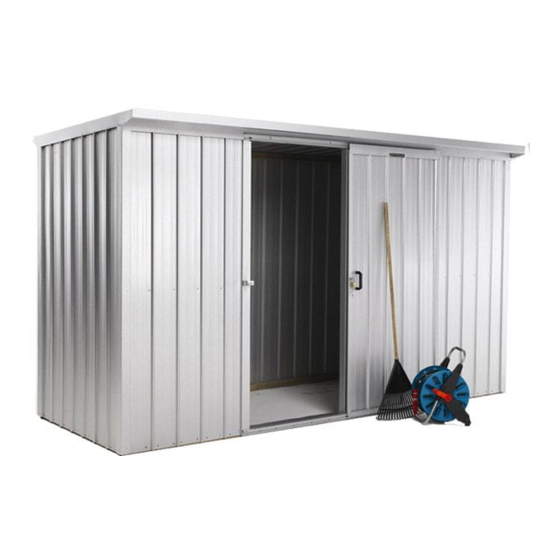
Advertisement
Quick Links
Advertisement

Subscribe to Our Youtube Channel
Summary of Contents for Duratuf KL3
- Page 1 Quality – Built In ASSEMBLY INSTRUCTIONS BASE SIZE 3380mm x 1210mm...
- Page 2 ASSEMBLY INSTRUCTIONS Tools Required: Drill Drill Bit 3.5mm Drill Bit 6mm (for clear roof panel only) Riveter Hammer Nail Punch Tape Measure Ladder or Saw stool Spanners x2 String Line ...
- Page 3 1.890m Wall Sheets 1.890m 1/2 Wall Sheets 1.450m Roof Sheets Door - Standard Security Instruction Booklet Hardware Pack Touch-up Paint & Brush 50mm Flooring Nails 75mm Flooring Nails Fixed Window Frame 0.580m Glaze Beads 0.603 x 0.603m Glass Louvre Window Frame 0.588 x 0.150m Glass Window Hardware Pack...
- Page 4 KL3 TIMBER FRAME 3380 1210 1622 1120 END WALL FRONT WALL...
- Page 5 KL3 TIMBER FRAME Note: For sheds with the Raised Floor Modification option the studs will be 1.780m long to allow the Wall Sheets to pro- trude 20mm below the Bottom Plate. Refer to Raised Floor Modification section (Page 15). Note: If fitting a window in the Back Wall, there will be no centre stud on that side.
-
Page 6: Terms Explanation
KL3 WALL CLADDING TO AVIOD CORROSION: Where at all possible try not to trap metal filings between two sheets. Remove all metal filings before riveting. Carbon in pencils reacts with the Zinc/Aluminium coating on steel. Use either crayon or ink to mark steel. - Page 7 KL3 WALL CLADDING 45mm BELOW Step 1: Front Wall: Position first wall sheet on the TOP OF RIDGE left hand side of the doorway with the sheet LIP BEAM on the left hand side. Ensuring the LIP is flush with the side of the corner Stud and the top is 45mm below the top of the Ridge Beam, tack in place.
- Page 8 KL3 WINDOW (Optional) LOUVRE WINDOW 588mm Step 2: On the inside of the shed, position studs Step 1: Lay out the two window studs (883mm) and and Nog centrally on window opening. Nog (634mm) on a flat surface. Position Nog and nail in place using 2x 75mm nails Make sure the studs are parallel and nail into Top Plate and End Wall Nog.
- Page 9 KL3 DOOR JAMB & CORNER FLASHINGS Step2: Measure and cut Doorstep Flashing (106) to Step1: Fit Door Jamb Flashing (104) in between fit in between Door Jambs. Position the Door- Top and Bottom Plates and hard against step Flashing in between the Door Jambs at Stud.
- Page 10 KL3 ROOF Note: Condensation can form on the under side of shed roof. If building paper is required, fit now. Building paper will need to be supported by netting or roofing twine. Roof with Clear Panel: Handle Clear Panel with care. The Clear Panel will crack if not fitted correctly.
- Page 11 KL3 DOOR Step 1: Position Door Track (107) on front wall 55mm down from underside of Roof, with left hand end flush with the left hand door jamb. Pre-drill hole in centre and rivet in place. Remove ALL drill filings Step 2: Hang door in Door Track.
- Page 12 DOOR BOTTOM PLATE DOOR GUIDE KL3 BARGE & SPOUTING Step 1: Position Barge Flashing (G102) on gable Step 2: Centralise Barge Flashing on end and ends. Position a Spouting (C103) and rivet rivet in place, one rivet into every second to the Barge Flashing at each end.
- Page 13 Floor. It is recommended that the shed is anchored down with either a Duratuf Bolt Down Kit or Duratuf Peg Down Kit depending on what the shed is sited on.
- Page 14 KL1 HASP & STAPLE Using six rivets and one 50mm clout attach hasp to Door Jamb Flashing and the staple to the Door as shown. (Note: See below for security option.) SECURITY DOOR (Optional) Attach “ T” locking handle with two Step 1: 8x10mm screws.
- Page 15 SECURITY DOOR (Optional) Step 3: On the left hand Door Jamb, position latch as shown, at correct height to door handle. Rivet in place with four rivets. RAISED FLOOR MODIFICATION For sheds being placed on a purpose built floor, (concrete, cob- bles, ply etc.), the Wall Sheets will protrude 20mm below the Base Plate.
-
Page 16: Warranty Registration
DURATUF PREMIUM SHED WARRANTY GUARANTEE TO CUSTOMER Congratulations on purchasing a Duratuf Storage Shed. With proper care and attention, this product will last many years. For your benefit PLEASE READ THE FOLLOWING INFORMATION CAREFULLY. WARRANTY ON METAL CLADDING Riverlea Group Ltd guarantee that the metal roofing and wall cladding on Kiwi and Fortress Garden Sheds may be used in moderate and inland corrosion zones or areas where the first year mild steel corrosion rate is less than 200g/m2, and that in these conditions, they will not perforate due to corrosion within 18 years of date of manufacture.












Need help?
Do you have a question about the KL3 and is the answer not in the manual?
Questions and answers